Using HTML in Domino Designer
Now that you understand basic HTML, it's time to see how it can be applied to Domino Designer. You can add HTML to a number of objects, such as hotspots, buttons , fields, views, forms, and pages. Beginning with Release 4.5, the "hooks" for HTML in a Domino database have increased, and in R5 and now Domino 6, you can add HTML to documents, pages, forms, fields, views, and many different objects. Some of these objects, such as fields and hotspots, have an Extra Field HTML tab on the properties box.
Converting Forms, Pages, and Subforms to HTML
A great new feature in Domino 6 allows designers to convert some or all content on a page, form, or subform directly into HTML on the fly. Designers then can use the HTML Editor to make changes to the HTML source code directly. Here's how:
- Open a page, form, or subform in Domino Designer.
- Select the contents of the page, form, or subform that you want to convert to HTML.
- Choose Edit, Convert to HTML. The selected contents are converted into HTML source code, as shown in Figure 20.5. Because not everything in Notes has an exact equivalent in HTML, the conversion to HTML is an approximation . You should always check your conversion results.
Figure 20.5. Converting page, form, or subform content to HTML.
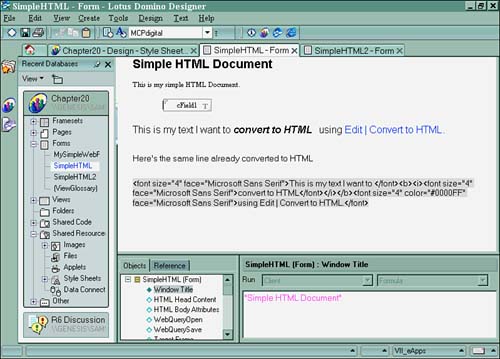
TIP
If part of your design is mistakenly converted to HTML, choose Edit, Undo Delete to recover your design. Do not choose Edit, Convert to Notes. The reconversion is not exact: Buttons that have Web or client JavaScript associated with the Click event are converted to HTML as expected. However, it is recommended that you not to convert buttons that do not have Web or client JavaScript associated with the Click event as a precaution.
- To use the HTML Editor, place the cursor anywhere in the newly created HTML source code and choose View, HTML Pane. The screen splits . The page, form, or subform appears in the top pane (in an embedded Internet Explorer browser control), and its HTML source code appears in the bottom pane.
- You can edit the HTML source code in the bottom pane. Click Refresh to see the results in the top pane of your HTML changes, as shown in Figure 20.6.
Figure 20.6. Viewing the HTML pane in Domino Designer.
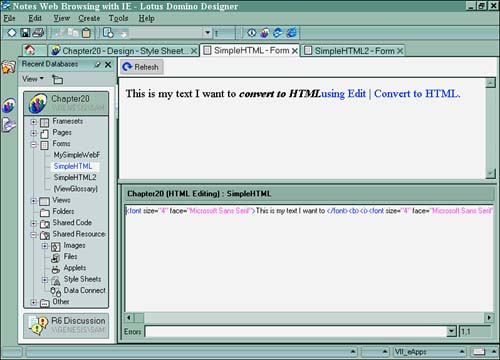
- Press Esc to exit the HTML Editor.
Importing HTML
Importing HTML code into Domino is very easy to do. To import HTML, you must first save the document that contains the HTML code you want to import.
- Open a page, form, or subform.
- Choose File, Import.
- Select the file containing the HTML you want to import, and click OK. Designer translates the HTML and then adds it to the page, form, or subform.
You can then edit the HTML code directly in the Domino HTML editor via the HTML pane (View, HTML Pane) with your page, form, or subform.
Adding HTML Head Content
Open a database in the Domino Designer and follow these instructions:
- In the Programmer's pane, click the Objects tab.
- Select the HTML Head Content event.
- Enter the HTML in the script area of the Programmer's pane. Enclose your code with quotes, as in this example:
"This is my bold text"
- Click the green check mark or perform a save (Ctrl+S) to validate your entry.
Adding HTML Attributes to a Field
Domino provides two places for designers to attach HTML to a field: The Field Extra HTML tab on the Field properties box and the HTML Attributes field event in the Objects pane.
To add HTML attributes, using the Field properties box, follow these steps:
- Double-click the field you want to format.
- The field's properties box displays. Select the last tab, Field Extra HTML, on the Field properties box.
- In the Other HTML tag field, enter the HTML code (without quotes). For example, to resize a text field from its default size of 20, enter the following in the Other HTML tag field:
SIZE=80 MAXLENGTH=100
The maxlength value defines the length of the text content a user can enter into the field. It is generally good practice to keep the maxlength value approximately 30% larger than the size value, to enable a user to completely fill a field with text.
- Save the form.
To add HTML attributes using the field's HTML Attributes event:
- Click the field you want to format.
- On the Objects tab of the info list in the Programmer's pane, select the HTML Attributes event for the field.
- Write the HTML code in quotes in the script area. For example, to define a rich-text field's properties, you would use this:
"ROWS=10 COLS=50"
- Save the form.
A rich-text field accepts ROWS and COLS tags to define the number of rows (height) and columns (width) that the browser displays for the field. For example, the following attribute sets the number of rows to 20 and the columns to 60 (see Figure 20.7):
"ROWS=20 COLS=60"
Figure 20.7. The HTML attributes of text and rich-text fields can be used to control the display of the field to a Web client.
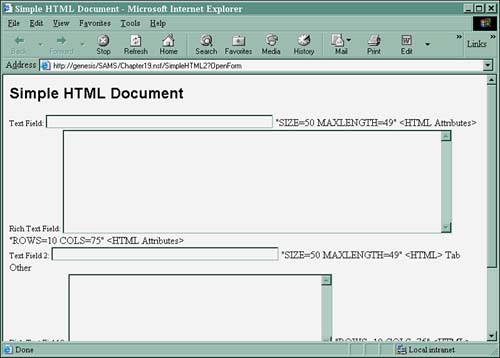
Adding the ROWS and COLS attributes to a rich-text field controls both the width ( COLS ) and the height ( ROWS ). Figure 20.8 shows the effects of setting the HTML attributes on text and rich-text fields.
Figure 20.8. Setting the HTML attributes of fields defines the way the field is displayed by the browser.
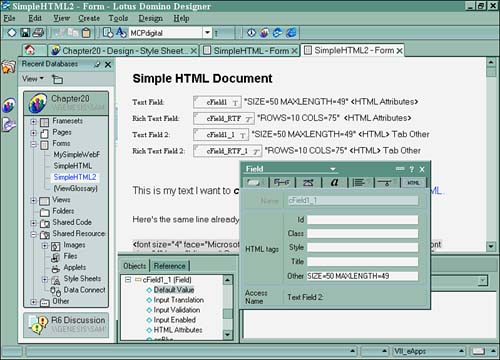
The HTML tab of the Field properties box is shown in Figure 20.8. This tab enables you to define several different aspects of an object. Table 20.5 describes each of the settings on the
tab.
Table 20.5. The
Tab of the Field Properties Box
| Attribute | Description |
|---|---|
| Name | Names the object, which can be referenced by JavaScript or with a style sheet |
| Id | Used to reference the object by JavaScript or with a style sheet |
| Class | Used to apply a class from a style sheet |
| Style | Applies a specific style to an object from a style sheet |
| Title | Used to provide a tip or a prompt to a user |
| Other | Adds other attributes (don't use quotes) for the object |
The Name attribute is preset for fields but is available for other objects, such as buttons. The Id attribute is similar to the Name attribute, and both are used to reference the object with JavaScript or a Cascading Style Sheet. Class and Style are used to apply styles from a style sheet. The Title attribute (at least in Internet Explorer) provides a little prompt box with the text you include when the mouse passes over the field or object (see Figure 20.9). Trick: Some designers also use this tag to pass field help or hints to the Web user.
Figure 20.9. Adding text (without quotes) to the Title attribute of an object produces a floating box in Internet Explorer; note the box Rich Text Field.
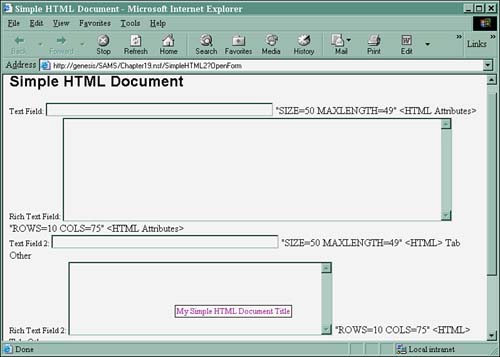
CAUTION
The Title attribute appears to function only in Internet Explorer. It does not work in Netscape 4.51 or in the Notes browser.
You can use the Other property to add additional HTML attributes to objects. For the most part, you can get at all the HTML attributes you'll ever need, so you'll rarely use this property. In the Other field, unlike the remaining fields on this tab, you must use quotation marks and identify the attribute. The syntax is as follows :
Attribute = "value"
Attributes entered into the HTML tab are incorporated into the document when it is presented to a Web client.
Using HTML in Forms and Pages
In addition to the techniques discussed previously, there are other ways to use HTML in forms, pages, and subforms. On the Advanced tab of the Form properties box is the setting Web Access: Treat Document Contents as HTML. Pages have a similar setting for Web Access Treat Page Contents as HTML on the Page Info tab. You can click this setting for either a page or a form, and then you can add HTML to the design object.
Pass-thru HTML became much more functional in R5 and Designer 6. In R4.6, pass-thru HTML wasn't very "sticky." That is, it didn't always stay set to pass-thru HTML; if you modified a form, the setting often disappeared. Now the text you've selected for pass-thru HTML shows up with a gray background so you always know when it's set.
CAUTION
If you try to create an HTML document with and other form tags, Domino produces an error message: Documents treated as HTML cannot be edited .
Because Domino creates all the necessary elements to create a basic HTML documentthat is, the
tags,
tags, appropriate JavaScript, and so onit doesn't make that much sense to completely re-create an HTML document from scratch within a page or a form. To get around this, select On Access Content Type to Notes and then select the option Generate HTML for All Fields on the Defaults tab of the form's InfoBox.
Using Reserved Fields
At present, three fields are reserved for HTML: $$HTMLHead, $$Return, and HTML. $$HTMLHead is a leftover from earlier versions of Notes and Domino. This field enables you to insert tags into the HEAD of an HTML document. It is not really needed any longer because forms and pages contain the HTML Head Content event. As with the HTML Head Content event, $$HTMLHead can take all sorts of tags, such as ,
Part I. Introduction to Release 6
Whats New in Release 6?
- Whats New in Release 6?
- A Brief History of Lotus Notes
- Major Features of Lotus Notes
- Types of Applications
- Whats New in Domino Designer?
- New Design Element Features
- New Language Features
The Release 6 Object Store
- The Release 6 Object Store
- Defining a Domino Database
- Understanding the Database Structure
- Creating a Database
- Working with Database Properties
- Understanding Design Templates
- Creating Your Own Templates
- Inheriting Designs from Templates
- Using Templates to Replicate Design Changes
- Using Templates as Design Libraries
- Archiving Versions with Templates
The Integrated Development Environment
- The Integrated Development Environment
- Working in the Application Design Environment
- Working with the Properties Box
- Understanding the Work Pane
- Using the Programmers Pane
- Understanding the Info List
- Understanding the Action Pane
- Customizing the Tools Menu
- Printing Source Code
- Using the HTML Editor
- Locking Design Elements
Part II. Foundations of Application Design
Forms Design
- Forms Design
- Designing Forms
- Setting Form Properties
- Working with Text Properties
- Working with Fields
- Writing Formulas in Fields
Advanced Form Design
- Advanced Form Design
- Working with Tables
- Using Graphic Objects on Forms
- Working with Form-Level Events
- Using Form Actions
- Working with Hotspots
- Understanding Sections and Section Properties
- Using Layout Regions
- Working with Special Forms
- Creating Reusable Design Objects
- Using Embedded Elements
- Using the Form Design Document
Designing Views
- Designing Views
- Defining the Elements of a View
- Creating a View
- Setting View Properties
- Creating Advanced View Selections
- Adding and Editing View Columns
- Using View Column Properties
- Adding Actions to a View
- Creating Calendar Views
- Understanding Folders
Using Shared Resources in Domino Applications
- Shared Resources
- Sharing Images Within a Database
- Creating Shared Files
- Creating Shared Applets
- Shared Code
- Creating Subforms
- Creating Shared Fields
- Creating Shared Actions
- Script Libraries
- Database Resources
Using the Page Designer
- Using the Page Designer
- Understanding Pages
- Working with the Page Properties Box
- Using the Page Designer
- Adding Layers to Your Pages
Creating Outlines
- Creating Outlines
- Creating an Outline
- Working with Outline Entries
- Embedding Outlines
- Adding an Outline to a Frameset
Adding Framesets to Domino Applications
- Adding Framesets to Domino Applications
- Creating a Frameset
- Using the Frameset Designer
- Working with Frames
- Viewing the HTML Source of Your Frameset
- Launching the Frameset
Automating Your Application with Agents
- Automating Your Application with Agents
- Working with Agents
- Creating an Agent
- Working in the Agent Builder Design Window
- Using @Commands in Agents
- Putting Your Agent to Work
- Creating a Complex Agent
- Using LotusScript in Agents
- Creating Web Agents Using Formulas and LotusScript
- Using Java in Agents
- Testing and Debugging Agents, the Agent Log, and Agent Properties
- Agent Properties via the Agent InfoBox
Part III. Programming Domino Applications
Using the Formula Language
- Using the Formula Language
- Overview of the Formula Language
- Knowing Where to Use @Functions and @Commands
- Formula Syntax
- Limitations of the Formula Language
- Working with Statements
- Using Logical @Functions
- Working with Date and Time @Functions
- Working with Strings
- Getting Session and User Information
- Working with Documents
- Retrieving Data with @DbColumn and @DbLookup
- Working with Lists
- Getting User Input
- Controlling the Flow of a Formula
- Error Handling
Real-World Examples Using the Formula Language
- Real-World Examples Using the Formula Language
- Programming Practices
- Using Formulas in Forms and Subforms
- Writing Field Formulas
- Writing View Formulas
- Using Hide When Formulas
- Working with Forms, Views, and Shared Actions
Writing LotusScript for Domino Applications
- Writing LotusScript for Domino Applications
- Software Construction
- Fundamental Elements of LotusScript
- New Technologies and LotusScript
Real-World LotusScript Examples
- Real-World LotusScript Examples
- Real-World Example 1: Importing a Delimited Text File
- Real-World Example 2: Delete a Parent Document and All Its Children: DeleteParentAndChildren
- Real-World Example 3: Schedule an Agent Robot to Refresh All the Documents in a View: Robot-DailyRefreshAllDocs
- Real-World Example 4: Return a Web User to the Place Where He Started After a Document Is Submitted: WebQuerySave-DocSubmit
Writing JavaScript for Domino Applications
- Writing JavaScript for Domino Applications
- What Is JavaScript?
- JavaScript Is Not Java
- JavaScript and the Domino IDE
- The Document Object Model
- JavaScript Support in Domino 6
- When to Use JavaScript
- A Look at JavaScript in Domino
- JavaScript Libraries in Domino
- JavaScript Principles 101
- Syntax and Command Blocks
- Statements
- Output
- Functions
- Objects
- Input Validation
- Validating Check Boxes
- Validating Radio Buttons
- Validating Selection Lists
- Calculations
- JavaScript Application
Real-World JavaScript Examples
- Real-World JavaScript Examples
- Real-World Example 1: Dynamic Drop-Down Lists on the Web
- Real-World Example 2: Dialog Boxes and window. opener on the Web
- Real-World Example 3: Dynamic Tables
- Real-World Example 4: Useful JavaScript Utilities
Writing Java for Domino Applications
- Writing Java for Domino Applications
- Introduction to Java
- Choosing a Java Solution in Domino
- Understanding the Notes Object Interface
- Writing Java Agents
- Using Other Java IDEs
- Other Uses for Java
Real-World Java Examples
Enhancing Domino Applications for the Web
- Enhancing Domino Applications for the Web
- Whats New in Designer 6
- Understanding the Domino Web Application Server
- Understanding the Basics of HTML
- Using HTML in Domino Designer
- Adding Power with Domino URLs
- Views and Forms Working Together on the Web
- Incorporating Flash into Your Web Pages
- What Its All About: XML Exposed
- How Does Domino Use XML?
Part IV. Advanced Design Topics
Accessing Data with XML
Accessing Data with DECS and DCRs
- Accessing Data with DECS and DCRs
- What Is DECS?
- The External Data Source
- DECS Administrator
- Creating the Activity
- Accessing the Application
- DECS Summary
- Data Connection Resources
- DCR Example
- Tips on External Data Access
Security and Domino Applications
- Security and Domino Applications
- How Does Domino Security Work?
- Enabling Physical Security
- Setting Server Access
- Database Access Control Lists
- The Role of the Domino Directory in Application Security
- ACL Privileges
- Enabling Database Encryption
- Using Roles
- Implementing View-Level Security
- Implementing Form-Level Security
- Implementing Document-Level Security
- Applying Field-Level Security
- Hiding the Design of Your Application
Creating Workflow Applications
- Creating Workflow Applications
- The Evolution of Groupware
- Introducing Workflow
- Creating Mail-Enabled Applications
- Using Triggers to Send Email
- Sending Mail with LotusScript
Analyzing Domino Applications
Part V. Appendices
Appendix A. HTML Reference
Appendix B. Domino URL Reference
EAN: 2147483647
Pages: 288
